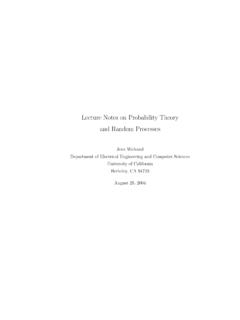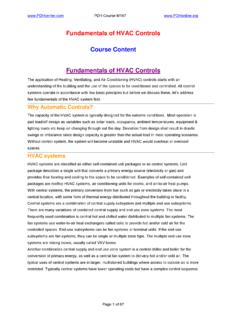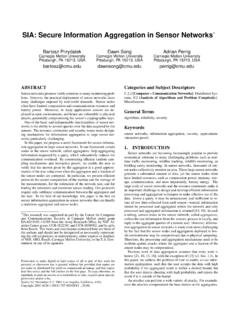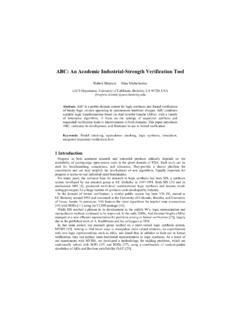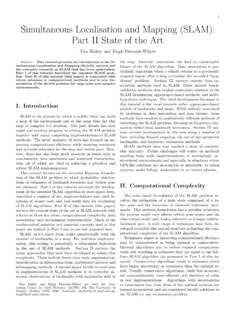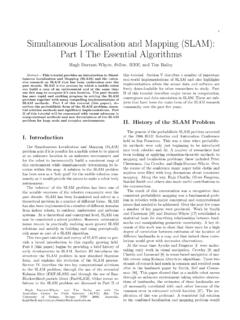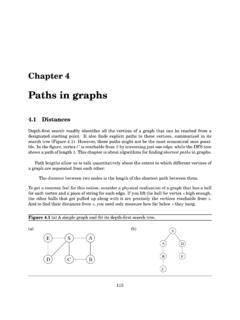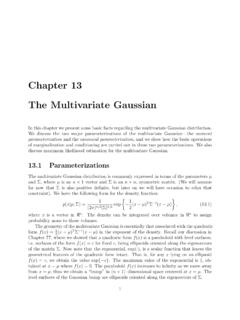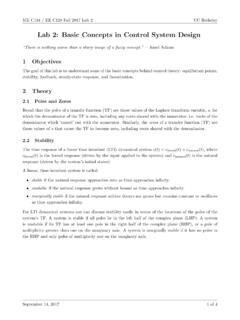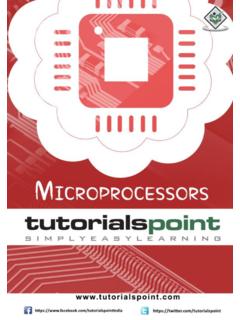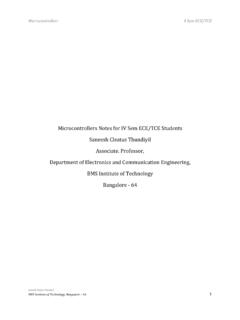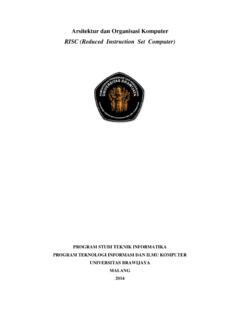Transcription of Design of the RISC-V Instruction Set Architecture
1 Design of the RISC-V Instruction Set Architecture Andrew Waterman Electrical Engineering and computer Sciences University of California at Berkeley Technical Report No. UCB/EECS-2016-1. January 3, 2016. Copyright 2016, by the author(s). All rights reserved. Permission to make digital or hard copies of all or part of this work for personal or classroom use is granted without fee provided that copies are not made or distributed for profit or commercial advantage and that copies bear this notice and the full citation on the first page. To copy otherwise, to republish, to post on servers or to redistribute to lists, requires prior specific permission. Design of the RISC-V Instruction Set Architecture by Andrew Shell Waterman A dissertation submitted in partial satisfaction of the requirements for the degree of Doctor of Philosophy in computer Science in the Graduate Division of the University of California, Berkeley Committee in charge: Professor David Patterson, Chair Professor Krste Asanovic.
2 Associate Professor Per-Olof Persson Spring 2016. Design of the RISC-V Instruction Set Architecture Copyright 2016. by Andrew Shell Waterman 1. Abstract Design of the RISC-V Instruction Set Architecture by Andrew Shell Waterman Doctor of Philosophy in computer Science University of California, Berkeley Professor David Patterson, Chair The hardware-software interface, embodied in the Instruction set Architecture (ISA), is arguably the most important interface in a computer system. Yet, in contrast to nearly all other interfaces in a modern computer system, all commercially popular ISAs are proprietary. A free and open ISA standard has the potential to increase innovation in microprocessor Design , reduce computer system cost, and, as Moore's law wanes, ease the transition to more specialized computational devices. In this dissertation, I present the RISC-V Instruction set Architecture . RISC-V is a free and open ISA that, with three decades of hindsight, builds and improves upon the original reduced Instruction Set computer (RISC) architectures.
3 It is structured as a small base ISA. with a variety of optional extensions. The base ISA is very simple, making RISC-V suitable for research and education, but complete enough to be a suitable ISA for inexpensive, low- power embedded devices. The optional extensions form a more powerful ISA for general- purpose and high-performance computing. I also present and evaluate a new RISC-V ISA. extension for reduced code size, which makes RISC-V more compact than all popular 64-bit ISAs. i Contents Contents i List of Figures iii List of Tables v 1 Introduction 1. 2 Why Develop a New Instruction Set? 3. MIPS .. 3. SPARC .. 5. Alpha .. 7. ARMv7 .. 8. ARMv8 .. 9. OpenRISC .. 11. 80x86 .. 11. Summary .. 13. 3 The RISC-V Base Instruction Set Architecture 15. The RV32I Base ISA .. 16. The RV32E Base ISA .. 27. The RV64I Base ISA .. 28. The RV128I Base ISA .. 30. Discussion .. 30. 4 The RISC-V Standard Extensions 32. Integer Multiplication and Division.
4 32. Multiprocessor Synchronization .. 34. Single-Precision Floating-Point .. 38. Double-Precision Floating-Point .. 45. Discussion .. 46. 5 The RISC-V Compressed ISA Extension 48. ii Background .. 48. Implications for the Base ISA .. 50. RVC Design Philosophy .. 51. The RVC Extension .. 55. Evaluation .. 59. The Load-Multiple and Store-Multiple instructions .. 66. Security Implications .. 69. Discussion .. 70. 6 A RISC-V Privileged Architecture 78. Privileged Software Interfaces .. 79. Four Levels of Privilege .. 80. A Unified Control Register Scheme .. 81. Supervisor Mode .. 82. Hypervisor Mode .. 86. Machine Mode .. 86. Discussion .. 87. 7 Future Directions 88. Bibliography 90. A User-Level ISA Encoding 99. iii List of Figures RV32I user-visible architectural state.. 17. RV32I Instruction formats.. 18. Code fragments to load a variable 0x1234 bytes away from the pc, with and without the AUIPC Instruction .
5 21. Sample code for reading the 64-bit cycle counter in RV32.. 27. RV32I user-visible architectural state.. 28. RV64I user-visible architectural state.. 29. Compare-and-swap implemented using load-reserved and store-conditional.. 35. Atomic addition of bytes, implemented with a word-sized LR/SC sequence.. 36. Orderings between accesses mandated by release consistency. The origin of an arrow cannot be perceived to have occurred before the destination of the arrow. 37. RVF user-visible architectural state.. 39. A routine that computes blog2 |x|c by extracting the exponent from a floating- point number, with and without the Instruction .. 44. Fused multiply-add Instruction format, R4.. 45. Frequency of integer register usage in static code in the SPEC CPU2006 bench- mark suite. Registers are sorted by function in the standard RISC-V calling convention. Several registers have special purposes in the ABI: x0 is hard-wired to the constant zero; ra is the link register to which functions return; sp is the stack pointer; gp points to global data; and tp points to thread-local data.
6 The a-registers are caller-saved registers used to pass parameters and return results. The t-registers are caller-saved temporaries. The s-registers are callee-saved and preserve their contents across function calls.. 52. Cumulative frequency of integer register usage in the SPEC CPU2006 benchmark suite, sorted in descending order of frequency.. 52. Frequency of floating-point register usage in static code in the SPEC CPU2006. benchmark suite. Registers are sorted by function in the standard RISC-V calling convention. Like the integer registers, the a-registers are used to pass parameters and return results; the t-registers are caller-saved temporaries; and the s-registers are callee-saved.. 53. iv Cumulative frequency of floating-point register usage in the SPEC CPU2006. benchmark suite, sorted in descending order of frequency.. 54. Cumulative distribution of immediate operand widths in the SPEC CPU2006. benchmark suite when compiled for RISC-V .
7 Since RISC-V has 12-bit imme- diates, the immediates in SPEC wider than 12 bits are loaded with multiple instructions and manifest in this data as multiple smaller immediates.. 54. Cumulative distribution of branch offset widths in the SPEC CPU2006 bench- mark suite. Branches in the base ISA have 12-bit two's-complement offsets in increments of two bytes ( 210 instructions ). Jumps have 20-bit offsets ( 218. instructions ).. 55. Static compression of RVC code compared to RISC-V code in the SPEC CPU2006. benchmark suite, Dhrystone, CoreMark, and the Linux kernel. The SPECfp outlier, lbm, is briefly discussed in the next section.. 60. SPEC CPU2006 code size for several ISAs, normalized to RV32C for the 32-bit ISAs and RV64C for the 64-bit ones. Error bars represent 1 standard deviation in normalized code size across the 29 benchmarks.. 62. Dynamic compression of RVC code compared to RISC-V code in the SPEC. CPU2006 benchmark suite, Dhrystone, CoreMark, and the Linux kernel.
8 63. Code snippet from libquantum, before and after adjusting the C compiler's cost model to favor RVC registers in hot code. The compiler tweak reduced the size of the code from 30 to 24 bytes.. 64. Speedup of larger caches, associative caches, and RVC over a direct-mapped cache baseline, for a range of Instruction cache sizes.. 65. Na ve method to compute the factorial of an integer, both without and with prologue and epilogue millicode calls.. 67. Sample implementations of prologue and epilogue millicode routines for saving and restoring ra and s0.. 67. Impact on static code size and dynamic Instruction count of compressed function prologue and epilogue millicode routines.. 68. Interpretation of eight bytes of RVC code, depending on whether the code is entered at byte 0 or at byte 2.. 69. The same ABI can be implemented by many different privileged software stacks. For systems running on real RISC-V hardware, a hardware abstraction layer underpins the most privileged execution environment.
9 79. v List of Tables Summary of several ISAs' support for desirable architectural features.. 14. RV32I opcode map.. 18. Listing of RV32I computational instructions .. 19. Listing of RV32I memory access instructions .. 22. Listing of RV32I control transfer instructions .. 23. Listing of RV32I system instructions .. 26. Listing of RV32I control and status registers.. 26. Listing of additional RV64I computational instructions .. 29. Listing of additional RV128I computational instructions .. 31. Listing of RV32M and (below the line) RV64M instructions .. 33. Listing of RVA instructions . The instructions with the w suffix operate on 32-bit words; those with the d suffix are RV64A-only instructions that operate on 64-bit words.. 37. Supported rounding modes and their encoding.. 40. Default single-precision NaN for several ISAs. QNaN polarity refers to whether the most significant bit of the significand indicates that the NaN is quiet when set, or quiet when clear.
10 The values come from [87, 67, 54, 47, 3, 8].. 41. Listing of RVF instructions .. 43. Classes into which the FCLASS Instruction categorizes Format of result of FCLASS. Instruction .. 45. Listing of RVD instructions .. 47. Twenty most common RV64 IMAFD instructions , statically and dynamically, in SPEC CPU2006. ADDI's outsized popularity is due not only to its frequent use in updating induction variables but also to its two idiomatic uses: synthesizing constants and copying registers.. 56. Major RVC Instruction formats, from [101].. 57. RV32C and RV64C Instruction listing.. 72. RV64C Instruction encoding.. 73. Reserved encodings in RV64C.. 74. vi SPEC CPU2006 code size for several ISAs, normalized to RV32C for the 32-bit ISAs and RV64C for the 64-bit ones. Thm2 is short for ARM Thumb-2; M is short for microMIPS.. 75. RVC instructions in order of typical static frequency. The numbers in the table show the percentage savings in static code size attributable to each Instruction .
